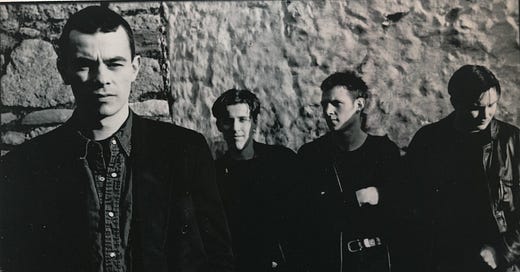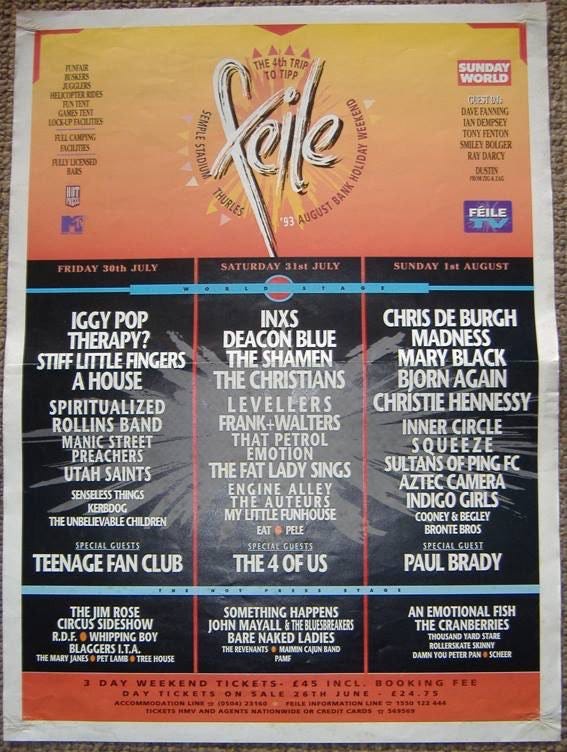Track 15: 'I wish that life could be just like a photograph...'
“If isolation is the furnace of transformation, I could be ashes by now.” ― stephen christian
Holed up in our squalid rehearsal room in the north inner city, we closed ranks, fuelled by a fierce sense of injustice after the bruising experience with Liquid Records, and a feeling that we had been callously cast aside.
There was a spark of anger, of defiance, a sense that we would come back stronger than ever.
We would show them all.
Around that time, we hit a rich vein of songwriting form; the words and music just seemed to pour out of us.
There was a real sense of purpose; ‘write about what you know’ became our guiding star, our mantra.
In an interview with Hot Press in 1993, Fearghal spoke about his new approach to writing lyrics:
"The actual thing about honesty is that, first of all, what I had to discover was, that to write anything properly at all, you have to first of all write honestly about yourself," Fearghal explains. "And you get through all the pages of waffle and you cut through all the bullshite and you get down to exactly trying to, I suppose explain the whole scenario of what you're doing, where you're going."
The bones of ‘Heartworm’ were fleshed out in that cramped space in the early months of 1993. There were no hangers-on, no distractions, no slipping out for a pint - it was just the four of us now, and it was all about creating new music with a laser-like focus.
We still played some shows around Ireland; but the focus now was on writing & rehearsing. Musically, there was no conscious change of direction, no grasping for a more commercial sound. We just wrote instinctively. We dumped what we didn’t like, and kept what connected with us, what felt real or raw.
Around that time, we decided to record a couple of tracks, a new demo. There was no real end goal – we just had all this new material and wanted to get some of the tracks down on tape.
We returned to Sun Studios in Temple Bar, recording with Chris O’Brien for the first time. Chris was one of the best engineers on the local music scene – he had worked on records with many of our peers and was always viewed as a safe pair of hands. You knew you were going to walk away from the studio with a decent sounding recording – he was meticulous, hard-working and had a really good ear for what worked, and what didn’t.
‘We Don’t Need Nobody Else’ was one of the tracks recorded at that session; the final mix sounded fantastic. We had been so well prepared going into the studio, the product of spending so much time in our little rehearsal space, honing the sound, trying out new ideas.
The demo was shipped off to the ‘Dave Fanning Show’, in the hope that he might give it a couple of spins, and our manager Dave took a few copies to send off to press and record companies.
Unbeknown to us, Chris O’Brien had also passed on the tape to Sony A& R in Ireland, thinking it might be something that would interest them.
This was the avenue that would eventually lead to us signing to Sony on the Columbia Records label.
We played the Féile festival for the second time in Thurles that summer, debuting some of the newer songs. This time around, we got a later slot on the Friday, but away from the main stage.
The crowd reaction to the newer songs was really positive; these songs seemed to connect with the audience in a way that the older numbers did not.
Playing the small stage in a packed marquee suited us better than the wide open space of the main stage. Fearghal was at his snarling, mercurial best, and we played the songs with a real intensity, despite having no soundcheck. As a band, the sound on stage was really important to us - it had to be loud, immersive, right on the edge, which caused all kinds of headaches for our sound engineers. But without that onstage ferocity, we always found it hard to really get into a gig.
For festivals and gigs in bigger venues, the band hear a different mix through the onstage monitors to the sound out front.
So very often, you might think you had played the best gig ever, only to find that the sound out front was tame and lacking. The opposite could also be true. That day at Féile, it all seemed to come together.
The Jim Rose Sideshow were the headline act on our stage, a modern day version of a circus freakshow. I recall standing at the urinals after the show beside one of the performers - when he walked away, he left behind a bowl full of regurgitated bugs and insects!
The things you remember…
Word filtered back that Sony really liked the demo tape, and wanted to hear more. We thought it was a joke at first.
In 1993, Suede released their self-titled debut album, Blur released ‘Modern Life is Rubbish’ and Nirvana’s ‘In Utero’ hit the shelves. ‘Creep’ had been a massive hit for Radiohead.
Guitar music was enjoying mainstream success.
Still, we remained sceptical that anyone in Sony would give us the time of day.
The Dublin music scene back then was pretty small, incestuous– word started to spread that there was interest in the band from a major label. That had the effect of piquing the interest of other industry heads, and pretty quickly, there was a real buzz when we played shows in the Rock Garden.
There were whispers that other labels might be interested; from looking dead and buried nine months before, there were now real signs of life -we had gone away and come back reinvented, a different beast. The rumours didn’t phase us - we had never really courted major label interest before.
We were sure it was all just idle gossip anyway.
But over the next few months, we would be proven very wrong. As momentum started to build, we would find ourselves thrust into the middle of bidding war between two of the biggest major labels in the world.
And that’s when the sharks really began to circle…..






Was the project arts center in March that year? My memory is first time hearing twinkle and we don’t need… and I saw one of the rock garden gigs. Both very different but both outstanding
What a great read. Dublin in 1993 was just a very small village.